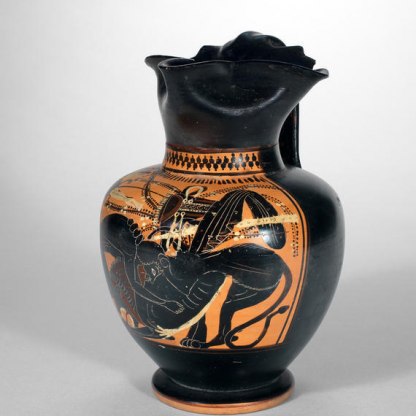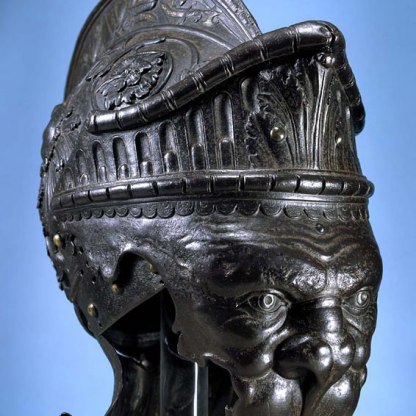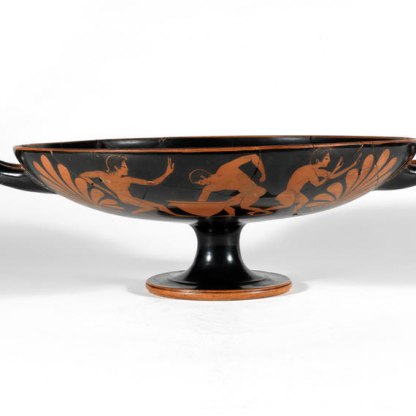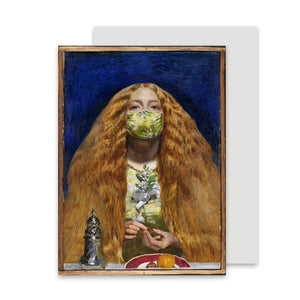
This tiny gem – 22 mm high, 17 mm wide and 8 mm deep – is one of only four surviving works signed by the engraver Dexamenos of Chios. His name is carved behind the legs of the stool on which the woman sits. Judging from the quality of his surviving work, Dexamenos was a major fifth-century artist, albeit one who worked on a very small scale.
Another word is engraved at the top of the gem: Mikes, meaning ‘of Mika,’ the name, or perhaps nickname, of the owner of the gem.
The woman sits upon a stool – called a diphros – her face in profile, her body in three-quarter view. She is elegantly dressed in a sleeveless garment secured by a belt. Her hair is bound up in a headcloth, and she raises a hand towards her face as she regards her reflection in a mirror held by a servant girl, who also holds a wreath.
Mirrors in the ancient world were made of highly polished metal. GR.10.1972 is a third-century BCE Etruscan mirror, made of copper with a bone handle much like that shown on the gem. The non-reflective side, shown in the photograph, is decorated with a scene from Homer’s epic poem, the Odyssey.
Dexamenos’ artistry is remarkable given the scale that he was working on. The detailed composition fits neatly into the oval field. The seated woman’s belly and breasts are clearly indicated beneath the folds of her almost diaphonous tunic. The right leg of the servant girl is likewise given volume beneath her skirt.
The enlargement of the gem in the photograph here shows up some flaws. The unsuccessful attempt to show the bottom of the stool in perspective, for example, has led to suggestions that this is an early work by the artist. But if the woman’s eye seems too big, her left foot a touch malformed, then this is scarcely noticeable when one views the work at its actual size. The gem, which was once set into a swivel ring, is both an enhancement and celebration of female beauty.
Though he came from the island of Chios, Dexamenos is thought to have worked in Athens where, in the fifth century BCE, women were generally confined to the home. Similar compositions to that on the gem are found on contemporary Athenian grave reliefs and painted pottery, and the quiet, domestic scene is in keeping with the social expectations of women at this time. Those who went beyond the expected roles of obedient wife and loving mother were viewed with suspicion. Greek drama, both comedy and tragedy, often deals with such transgressive females.
In his History of the Peloponnesian War, the great fifth-century historian Thucydides records a funeral oration delivered by the charismatic Athenian statesman Pericles. Addressed to the people of Athens after a year’s fierce fighting with Sparta, the speech praises the young men who have laid down their lives for their city and describes Athens' own uniqueness and might. After extolling the illustrious dead, Pericles addresses the war widows. The greatest glory for a woman, he says, is 'not to show more weakness than is natural to her sex ... and not to be talked about for good or for evil among men'.
Sitting quietly in her boudoir with her female attendant, the woman on Mika's gem is perhaps to be seen as a paragon of fifth-century Athenian femininity.
The Fitzwilliam owns a large collection of classical gems including one, signed by Dioskourides, the artist who engraved the signet ring of the first Roman Emperor, Augustus (63 BCE-14 CE). It depicts the Roman god Mercury (Greek Hermes) standing face forwards, wearing a travelling hat and cloak and carrying his caduceus (herald’s staff).
Themes and periods
Data from our collections database
Seated woman in sleeveless chiton, profile to right, looking in mirror held by servant girl. Inscription 'belonging to Mike' and 'made by Dexamenos'
Leake collection
Legal notes
Purchased
Acquisition and important dates
- Method of acquisition: Bought









